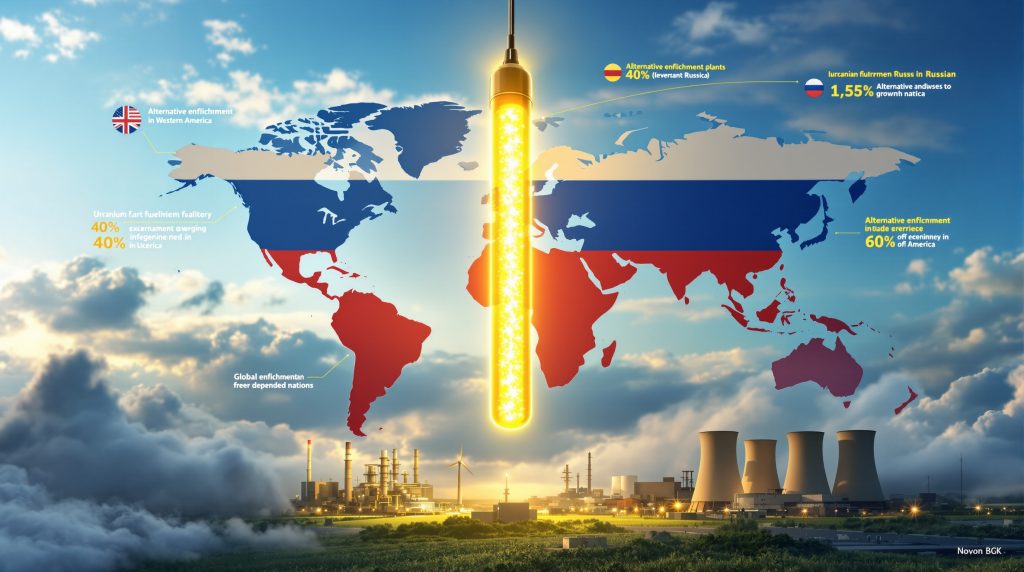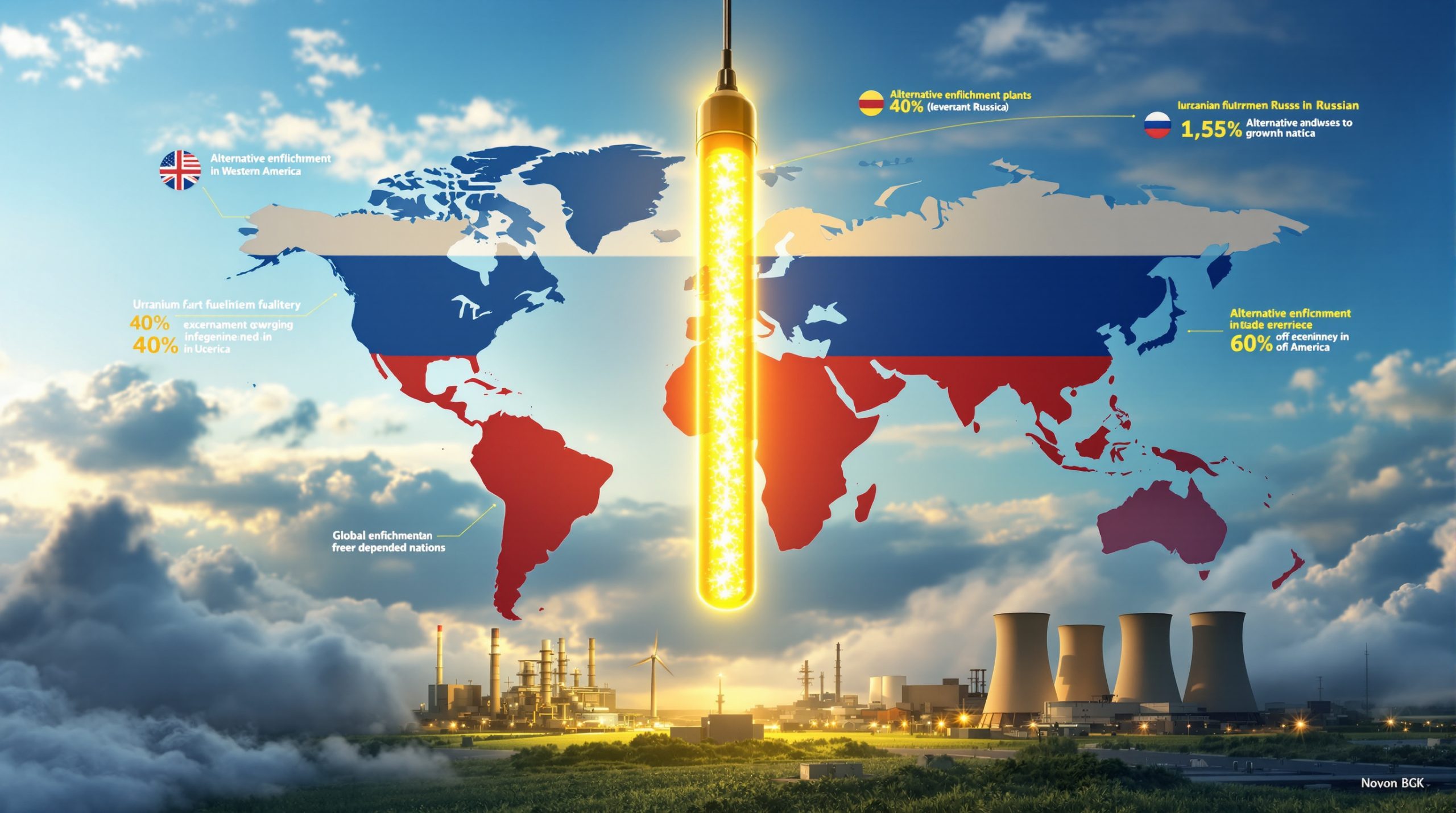The Global Challenge of Reducing Dependence on Russian Uranium
Russia has established itself as the world's primary supplier of enriched uranium, controlling approximately 40% of the global market. This dominance creates significant energy security challenges for countries seeking to reduce their dependence on Russian uranium. Unlike other energy resources where alternatives can be quickly secured, the specialized nature of uranium enrichment has created a bottleneck that many nations struggle to overcome.
The concentration of enrichment capacity in Russian hands represents a strategic vulnerability for Western nations, particularly as geopolitical tensions continue to rise. This dominance extends beyond raw uranium to include the critical enrichment process that transforms natural uranium into fuel suitable for nuclear reactors.
How Did Russia Gain Control of the Global Uranium Market?
Historical Development of Russia's Nuclear Industry
Russia's current dominance stems from decades of strategic investment in nuclear technology dating back to the Soviet era. Following the collapse of the Soviet Union, Russia maintained and expanded its nuclear infrastructure while Western nations reduced investments in their domestic uranium sectors.
The state nuclear corporation Rosatom has systematically built a vertically integrated nuclear supply chain that spans uranium mining, conversion, enrichment, and fuel fabrication. This comprehensive approach has allowed Russia to offer competitive pricing and reliable supply arrangements that were attractive to nuclear plant operators worldwide.
The Economics of Uranium Enrichment
Uranium enrichment requires substantial upfront investment in specialized facilities and technologies. The economics favor large-scale operations with high utilization rates, creating significant barriers to entry for new market participants. Russia leveraged its existing Soviet-era infrastructure to maintain cost advantages that competitors struggled to match.
The enrichment process is energy-intensive, and Russia's access to low-cost natural gas provided additional competitive advantages. These economic factors helped cement Russia's position as the dominant supplier, with few commercial incentives for alternative producers to enter the market until recent uranium market volatility triggered by geopolitical developments.
What is the Current State of Global Dependence?
Key Statistics on Russian Uranium Market Share
Russia supplies approximately 40% of the world's enriched uranium, creating a significant dependency for many nuclear power operators. According to Thunder Said Energy's analysis of uranium enrichment by country, the remaining market share is divided among China (17%), France (12%), the United States (11%), the Netherlands (8%), the United Kingdom (7%), and Germany (6%).
In the European Union, Russia continues to supply 38% of enriched uranium and 23% of raw uranium as of 2023, according to the Bruegel think-tank. The EU spent approximately $1.18 billion on Russian nuclear fuel in 2024, highlighting the scale of this dependency.
Critical Vulnerabilities in the Supply Chain
Five EU countries—Bulgaria, the Czech Republic, Finland, Hungary, and Slovakia—operate Russian-designed reactors specifically engineered to use Russian fuel. While four of these nations have signed agreements with alternative suppliers, Hungary has not yet secured alternative arrangements.
The specialized nature of these reactors creates technical challenges for fuel substitution, as alternative fuels must be carefully designed and tested to ensure compatibility and safety. This technical lock-in extends the timeline for reducing dependence even when political will exists.
Why Can't Countries Simply Switch Suppliers?
Technical Barriers to Diversification
Nuclear reactors are designed for specific fuel types, and changing fuel suppliers requires extensive safety testing and regulatory approvals. For Russian-designed reactors (VVER models), this transition is particularly challenging and time-consuming.
The enrichment process itself requires highly specialized technology subject to strict non-proliferation controls, limiting the number of potential new market entrants. These technical constraints mean that even with significant investment, building alternative capacity takes years, not months.
Limited Global Enrichment Capacity
Current global enrichment capacity outside Russia is insufficient to meet demand if Russian supplies were suddenly unavailable. Expanding enrichment capacity requires substantial investment in facilities that take 5-10 years to develop and license.
The specialized workforce needed for uranium enrichment represents another constraint, as the nuclear industry has faced challenges in attracting and training new talent after decades of limited growth in Western markets.
How is Global Uranium Demand Expected to Change?
Projected Growth in Nuclear Energy
According to the World Nuclear Association's September 2025 report, global uranium demand is projected to increase by nearly a third to approximately 86,000 tonnes by 2030, and could reach 150,000 tonnes by 2040. This growth reflects renewed interest in nuclear power as a low-carbon energy source.
The development of small modular reactors (SMRs) and advanced reactor designs could further accelerate demand growth, particularly as countries seek to balance decarbonization goals with energy security concerns.
Supply-Demand Imbalance on the Horizon
Production from existing uranium mines is expected to decline by approximately 50% between 2030 and 2040, creating a significant supply gap that must be addressed through new mining operations or alternative fuel cycles.
This projected supply shortfall increases the urgency of developing new sources of uranium and enrichment capacity outside of Russian control. Furthermore, recent developments like Paladin Energy uranium halt in Namibia have heightened concerns about global supply security.
What Efforts Are Underway to Reduce Russian Uranium Dependence?
European Initiatives and Challenges
The European Commission has acknowledged the need to reduce reliance on Russian nuclear fuel but has prioritized addressing natural gas dependencies first. The EU energy commissioner Dan Jorgensen has indicated that measures targeting enriched uranium will follow gas-focused initiatives, stating the nuclear question is "complicated" due to security of supply concerns, as reported by Reuters in June 2025.
European enrichment company Urenco (a Dutch-British-German consortium) terminated all Russian contracts in 2022 and is working to increase its Low Enriched Uranium (LEU) capacity by 1.8 million Separative Work Units across its facilities in the United States, Netherlands, Germany, and United Kingdom.
U.S. Strategic Response
The US uranium production surge has been remarkable, growing from 22,680 kg in 2023 to 307,082 kg in 2024, according to the U.S. Energy Information Administration. This represents a dramatic expansion aimed at reducing reliance on imported uranium.
The U.S. has also conducted extensive exploration drilling activities, completing 1,324 holes in 2024. Previous administration initiatives to expand domestic commercial LEU production included selecting six companies for potential contracts to procure domestically-sourced LEU, though current policies may vary under the Trump administration.
The US uranium import ban on Russian material has accelerated the need for domestic and allied production capacity.
United Kingdom's HALEU Development
In 2024, the UK announced plans to develop Europe's first high-assay low-enriched uranium (HALEU) facility, positioning itself as a pioneer in advanced nuclear fuel production. The government awarded $267.1 million to Urenco for this project.
The UK facility is expected to begin producing fuel in 2031, with capacity for both domestic use and export. This long-term investment reflects the extended timelines required for developing new nuclear fuel infrastructure.
What Are the Key Challenges to Building Alternative Supply?
Regulatory and Financial Hurdles
Nuclear facilities face stringent regulatory requirements that extend development timelines and increase costs. The specialized nature of uranium enrichment adds additional layers of oversight related to non-proliferation concerns.
The capital-intensive nature of uranium mining and enrichment requires long-term investment horizons that can be difficult to secure in competitive energy markets. Government support or guarantees are often necessary to enable the required investments.
Technical Expertise and Infrastructure Gaps
The specialized workforce required for uranium mining, processing, and enrichment represents a significant constraint after decades of limited investment in these sectors in Western nations. Rebuilding this expertise base requires time and educational investment.
The supporting infrastructure for uranium production and processing, from specialized transportation to waste management facilities, must be developed in parallel with production capacity. These interdependent systems add complexity to supply chain diversification efforts.
How Long Will Reducing Russian Uranium Dependence Take?
Realistic Timelines for Transition
Even with accelerated investment, developing alternative uranium enrichment capacity typically requires 5-10 years from initial planning to commercial operation. This reflects the complex engineering, regulatory, and construction requirements for these specialized facilities.
For countries operating Russian-designed reactors, fuel qualification programs for alternative suppliers can take 3-5 years to complete, extending the timeline for full independence from Russian fuel sources.
Balancing Short-term Security and Long-term Independence
In the near term, many countries are building strategic reserves of nuclear fuel to provide a buffer against potential supply disruptions. These stockpiles can typically cover 2-3 years of operation, providing time for alternative supplies to be developed.
The transition away from Russian uranium will likely occur in phases, with different market segments achieving independence on different timelines based on technical constraints and economic factors.
What Does the Future of Global Uranium Supply Look Like?
Emerging Suppliers and Technologies
Kazakhstan currently leads global uranium production, contributing approximately 40% of the world's supply. Expanding production in Kazakhstan, Australia, Canada, and emerging producers could help diversify the raw uranium supply base.
Advanced nuclear technologies, including fuel recycling and thorium-based fuel cycles, could potentially reduce dependence on traditional uranium supplies in the longer term. However, these technologies require significant development before commercial deployment.
The Role of International Cooperation
Multilateral initiatives to secure uranium supplies, such as the IAEA's nuclear fuel bank, could play an expanded role in ensuring fuel security during the transition away from Russian dependence.
Strategic partnerships between uranium-producing nations and those with enrichment technology could accelerate the development of alternative supply chains. These arrangements would need to balance commercial interests with broader energy security objectives.
Market Complexity and Growth Prospects
The uranium market is experiencing annual growth of between 1-2% according to industry estimates. Boris Schucht, CEO of Urenco, described it as a "small, growing market" that is "limited" and "very expensive to develop technologies," making it "pretty complex" in a CNBC interview from September 2025.
This market complexity creates both challenges and opportunities for new entrants seeking to capture market share from Russian suppliers. For investors considering this sector, developing effective uranium investment strategies requires understanding these technical and market barriers.
Conclusion: The Path Forward for Nuclear Fuel Security
Reducing dependence on Russian uranium presents significant challenges but remains a strategic priority for many nations. The combination of technical constraints, regulatory requirements, and economic factors means that this transition will require sustained investment over a period of years rather than months.
The renewed interest in nuclear energy as a low-carbon power source adds urgency to addressing fuel supply vulnerabilities. Countries pursuing nuclear expansion will need to incorporate fuel security considerations into their planning processes to ensure long-term viability.
Ultimately, building resilient nuclear fuel supply chains will require a coordinated approach involving government policy, private investment, and international cooperation. While complete independence from Russian uranium may not be achievable in the short term, incremental progress toward diversification can significantly reduce vulnerabilities over time.
Disclaimer: The projections and timelines discussed in this article involve uncertainty and are subject to change based on geopolitical developments, technological innovations, and policy shifts. Readers should consult with energy security experts and official sources for the most current information regarding uranium supply chains.
Want to Profit from the Next Major Mineral Discovery?
Stay ahead of the market with real-time alerts on significant ASX mineral discoveries through Discovery Alert's proprietary Discovery IQ model, turning complex mineral data into actionable investment insights. Discover why major mineral discoveries can lead to substantial returns by exploring the dedicated discoveries page and begin your 30-day free trial today.




